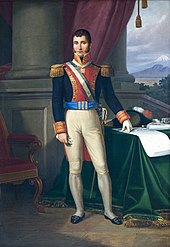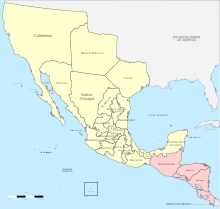Empire of Mexico (1821–1823)
| Imperio Mexicano | |||||
| Mexican Empire | |||||
| 1821-1823 | |||||
|
|||||
|
Motto : Religión, Independencia, Unión. ( Span. For "religion, independence, unity" ) |
|||||
| Official language | Spanish | ||||
| Capital | Mexico city | ||||
| Form of government | Constitutional monarchy | ||||
| Head of state | Emperor Augustine I (1821–1823) |
||||
| Head of government | Prime Minister José Manuel de Herrera (1821–1823) |
||||
| surface | 4,925,283 km² | ||||
| population | 6,500,000 | ||||
| Population density | 1.3 inhabitants per km² | ||||
| currency | Mexican real | ||||
| independence | declared by Spain in 1810, recognized in 1821 | ||||
| The first Mexican Empire | |||||
The Empire of Mexico ( Spanish Imperio Mexicano ) existed from 1821 to 1823 in North and Central America on the territory of today's republics of Mexico , Costa Rica , El Salvador , Guatemala , Honduras and Nicaragua as well as the southwest of what is now the United States . The Empire emerged from the Spanish colony of New Spain . The monarchy was abolished after the abdication of Emperor Augustine I on March 19, 1823 and the first Mexican republic was founded.
prehistory
The deposition of the Bourbon ruler Ferdinand VII by Napoleon and the proclamation of his brother Joseph as the new Spanish king after the French occupation of Spain in 1807 resulted in an independence movement being formed in Mexico. The cause was the loyalty of the Mexican conservatives and landowners to the Bourbons and the rejection of the liberal policies of the Bonapartes. An alliance of the conservatives, who were in favor of the previous status quo ante bellum , and the liberals, who aspired to an independent, democratic Mexico, emerged from this shared conviction . Both groups were convinced that Mexico had to go its own way and become independent.
The Mexicans took advantage of this weakness in Spain and on September 16, 1810, the Mexican declaration of independence was made by Miguel Hidalgo , which triggered the war of independence. Inspired by the abdication of the Spanish kings Charles IV and Ferdinand VII , another priest, José María Morelos, declared Mexico's independence on November 6, 1813 . However, the ensuing uprisings were quickly put down by the resurgent Spanish troops, who profited from the liberation of Spain.
However, from 1820 the Spanish troop leader Agustín de Iturbide sympathized with the rebels, went over to the rebels with his soldiers and took over the coordination of the individual rebel groups. At the beginning of 1821 he worked with other rebel leaders to develop the Iguala plan and formulated the idea of a secular , independent and united Mexico.
After the insurgents were able to push the Spanish troops back further and further, the Spaniards changed their strategy and paid dearly for the independence of Mexico. As the leader of the independence movement, Itúrbide signed the Treaty of Cordoba on August 24, 1821 with the viceroy Juan O'Donojú , in which Spain recognized the independence of Mexico in return for the payment of property. The reparations payments, however, together with the large land holdings of the remaining Spaniards, led to political instability over the next few decades. This is how Mexico gained independence, but was already economically bankrupt.
development
After Itúrbide had secured the loyalty of the remaining rebel groups, the Congress proclaimed him on May 19, 1822 as Augustín I Emperor of Mexico. However, this was only intended as a temporary solution until a member of a European ruling family agreed to rule Mexico. The plan did not work, however, as the Spaniards were still hoping to return to Mexico and no European ruling house accepted this offer. On July 21, 1822, Augustín I was finally coronated as emperor in Mexico City, following the example of Napoleon.
Augustin I's style of government was authoritarian and criticized by Congress. The Kaiser then dissolved the Congress on October 31. The discontent of the political elite led to the Casa Mata plan of 1823, which was worked out by Antonio López de Santa Anna and Guadalupe Victoria , among others . This provided for the overthrow of the emperor and the establishment of a republic. On December 1, 1822, the troops of Santa Anna revolted in Veracruz and proclaimed the republic. Augustín was preceded by his fall and voluntarily resigned on March 19, 1823 and agreed to leave the country. He went into exile in Italy and later in London . Then 17 of the 18 provinces of Guatemala separated with the exception of Chiapas and founded the Central American Confederation on July 1, 1823 .
On October 4, 1823, the Republic of Mexico was proclaimed and a new constitution was passed. On July 15, 1824, Augustín returned to Mexico and landed in the port of Tampico . He was arrested there and executed a short time later.
Territory parts
The Mexican Empire was divided into the following 24 areas:
Parts of Veracruz remained under Spanish occupation until after the collapse of the Empire, for example San Juan de Ulúa until 1825. Parts of the Yucatán also withdrew from the rule of the Empire.
literature
- Walther L. Bernecker, Horst Pietschmann, Hans W. Tobler: A Little History of Mexico. Suhrkamp, Frankfurt am Main 2007, ISBN 978-3-518-45621-7 .
- Timothy E. Anna: The mexican empire of Iturbide. University of Nebraska, Lincoln 1990, ISBN 0-8032-1027-2 .
- Francisco Castellanos: El trueno. Gloria y martirio de Augustin de Iturbide. Ed. Diana, Mexico 1982, ISBN 968-13-1304-6 .
Web links
- Empire of Mexico (English)
- The ruling house of Mexico (English)






